Sickle Cell Anemia: Pathophysiology, Diagnosis, and Management
VerifiedAdded on 2022/08/19
|8
|1949
|17
Report
AI Summary
This report provides a comprehensive overview of sickle cell anemia, a genetic blood disorder. It begins with an introduction to the disease, its prevalence, and its impact on affected individuals. The report then delves into the epidemiology of sickle cell anemia, discussing its global distribution and the genotypes associated with the condition. It explores the various risk factors and comorbidities linked to the disease. The report outlines the time frame and clinical presentation of sickle cell anemia, including common signs and symptoms such as pain, fatigue, and organ damage. It covers diagnostic procedures, including blood tests, HPLC, and genetic testing, used to confirm the presence of the disease. The report also examines the pathophysiology of sickle cell anemia, explaining the underlying genetic mutation and its effects on red blood cells. Finally, it discusses various treatment options, including medications, lifestyle modifications, and psychological support, aimed at managing the disease and improving the quality of life for patients. The report concludes by emphasizing the importance of early diagnosis and management to prevent complications and improve outcomes.
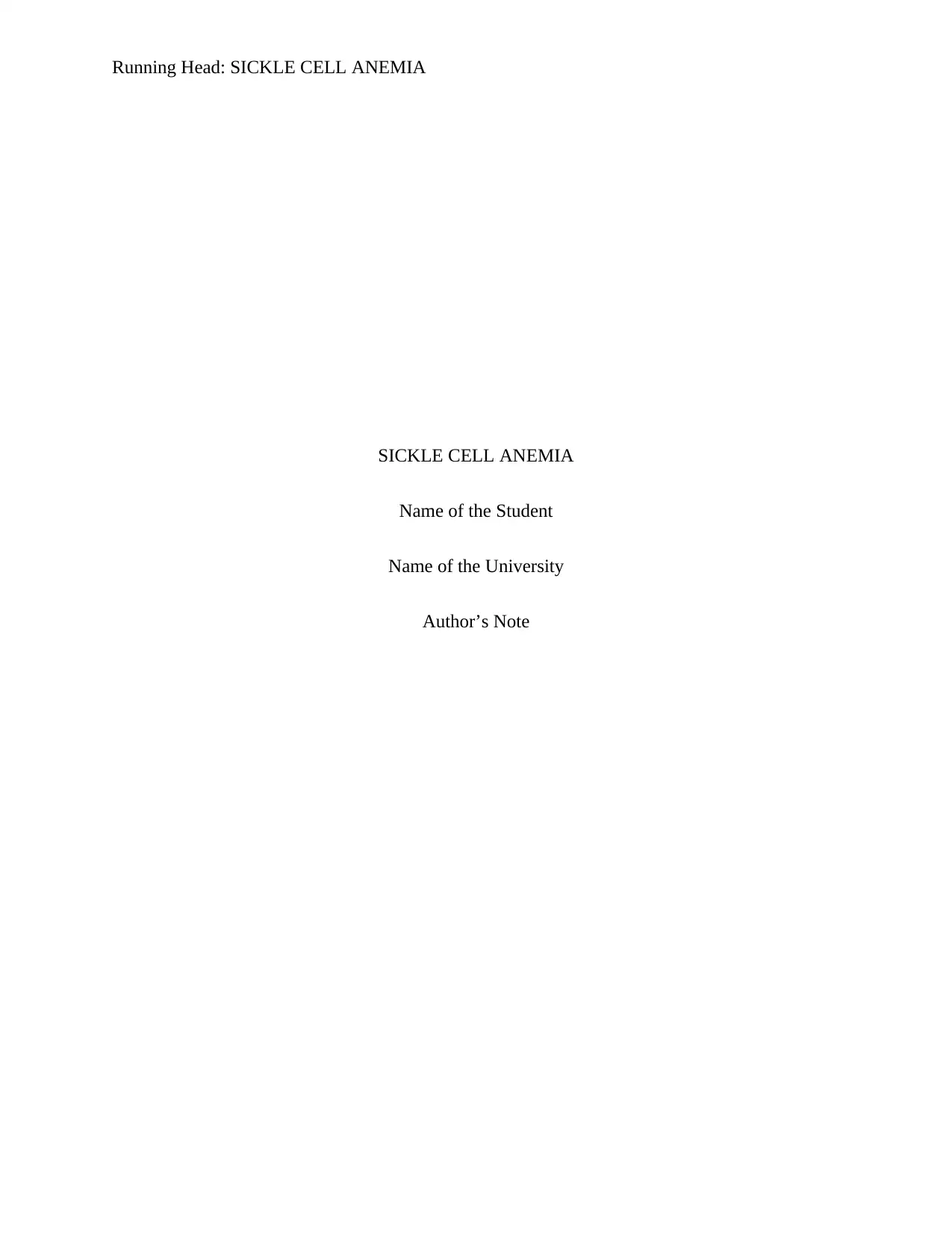
Running Head: SICKLE CELL ANEMIA
SICKLE CELL ANEMIA
Name of the Student
Name of the University
Author’s Note
SICKLE CELL ANEMIA
Name of the Student
Name of the University
Author’s Note
Paraphrase This Document
Need a fresh take? Get an instant paraphrase of this document with our AI Paraphraser
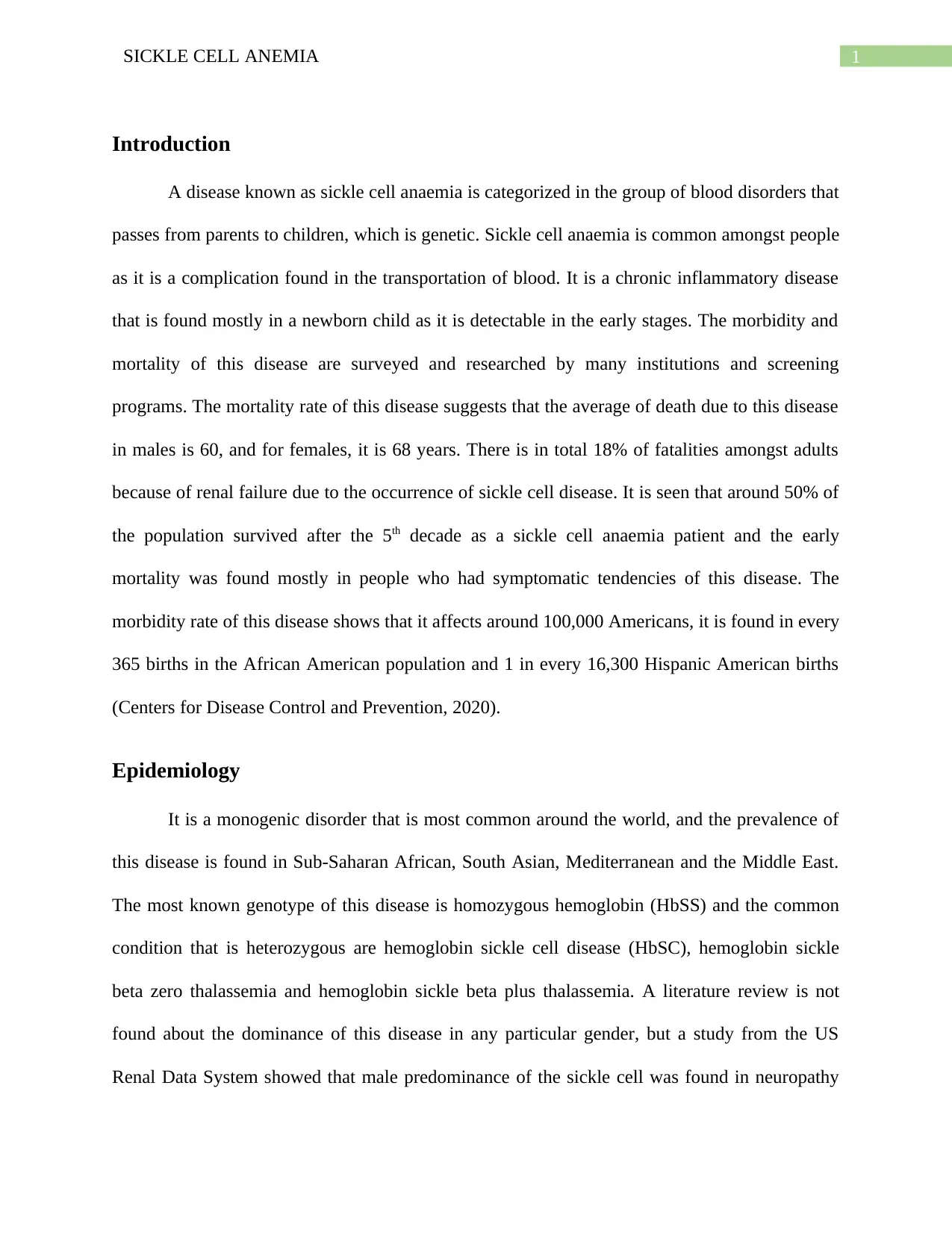
1SICKLE CELL ANEMIA
Introduction
A disease known as sickle cell anaemia is categorized in the group of blood disorders that
passes from parents to children, which is genetic. Sickle cell anaemia is common amongst people
as it is a complication found in the transportation of blood. It is a chronic inflammatory disease
that is found mostly in a newborn child as it is detectable in the early stages. The morbidity and
mortality of this disease are surveyed and researched by many institutions and screening
programs. The mortality rate of this disease suggests that the average of death due to this disease
in males is 60, and for females, it is 68 years. There is in total 18% of fatalities amongst adults
because of renal failure due to the occurrence of sickle cell disease. It is seen that around 50% of
the population survived after the 5th decade as a sickle cell anaemia patient and the early
mortality was found mostly in people who had symptomatic tendencies of this disease. The
morbidity rate of this disease shows that it affects around 100,000 Americans, it is found in every
365 births in the African American population and 1 in every 16,300 Hispanic American births
(Centers for Disease Control and Prevention, 2020).
Epidemiology
It is a monogenic disorder that is most common around the world, and the prevalence of
this disease is found in Sub-Saharan African, South Asian, Mediterranean and the Middle East.
The most known genotype of this disease is homozygous hemoglobin (HbSS) and the common
condition that is heterozygous are hemoglobin sickle cell disease (HbSC), hemoglobin sickle
beta zero thalassemia and hemoglobin sickle beta plus thalassemia. A literature review is not
found about the dominance of this disease in any particular gender, but a study from the US
Renal Data System showed that male predominance of the sickle cell was found in neuropathy
Introduction
A disease known as sickle cell anaemia is categorized in the group of blood disorders that
passes from parents to children, which is genetic. Sickle cell anaemia is common amongst people
as it is a complication found in the transportation of blood. It is a chronic inflammatory disease
that is found mostly in a newborn child as it is detectable in the early stages. The morbidity and
mortality of this disease are surveyed and researched by many institutions and screening
programs. The mortality rate of this disease suggests that the average of death due to this disease
in males is 60, and for females, it is 68 years. There is in total 18% of fatalities amongst adults
because of renal failure due to the occurrence of sickle cell disease. It is seen that around 50% of
the population survived after the 5th decade as a sickle cell anaemia patient and the early
mortality was found mostly in people who had symptomatic tendencies of this disease. The
morbidity rate of this disease shows that it affects around 100,000 Americans, it is found in every
365 births in the African American population and 1 in every 16,300 Hispanic American births
(Centers for Disease Control and Prevention, 2020).
Epidemiology
It is a monogenic disorder that is most common around the world, and the prevalence of
this disease is found in Sub-Saharan African, South Asian, Mediterranean and the Middle East.
The most known genotype of this disease is homozygous hemoglobin (HbSS) and the common
condition that is heterozygous are hemoglobin sickle cell disease (HbSC), hemoglobin sickle
beta zero thalassemia and hemoglobin sickle beta plus thalassemia. A literature review is not
found about the dominance of this disease in any particular gender, but a study from the US
Renal Data System showed that male predominance of the sickle cell was found in neuropathy
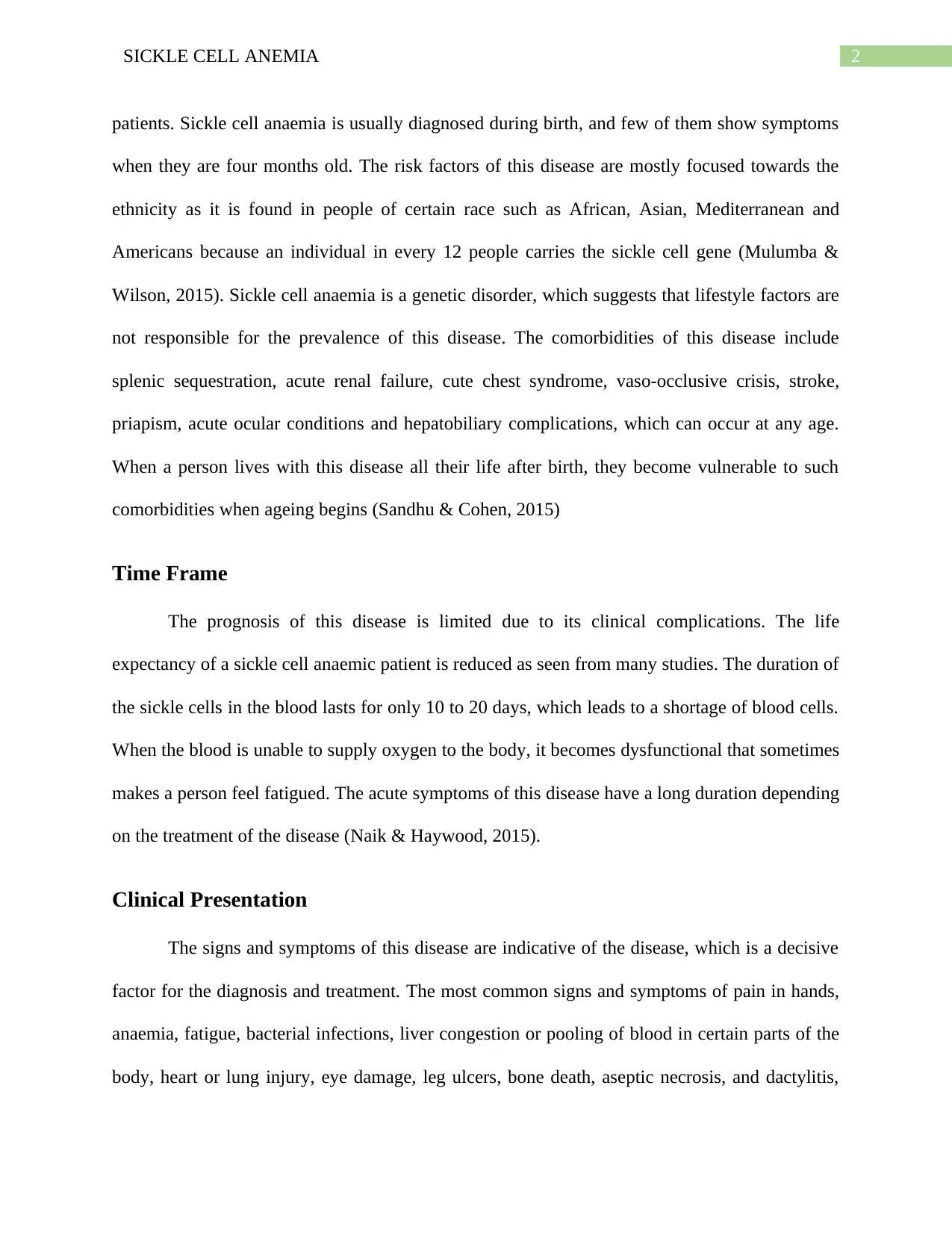
2SICKLE CELL ANEMIA
patients. Sickle cell anaemia is usually diagnosed during birth, and few of them show symptoms
when they are four months old. The risk factors of this disease are mostly focused towards the
ethnicity as it is found in people of certain race such as African, Asian, Mediterranean and
Americans because an individual in every 12 people carries the sickle cell gene (Mulumba &
Wilson, 2015). Sickle cell anaemia is a genetic disorder, which suggests that lifestyle factors are
not responsible for the prevalence of this disease. The comorbidities of this disease include
splenic sequestration, acute renal failure, cute chest syndrome, vaso-occlusive crisis, stroke,
priapism, acute ocular conditions and hepatobiliary complications, which can occur at any age.
When a person lives with this disease all their life after birth, they become vulnerable to such
comorbidities when ageing begins (Sandhu & Cohen, 2015)
Time Frame
The prognosis of this disease is limited due to its clinical complications. The life
expectancy of a sickle cell anaemic patient is reduced as seen from many studies. The duration of
the sickle cells in the blood lasts for only 10 to 20 days, which leads to a shortage of blood cells.
When the blood is unable to supply oxygen to the body, it becomes dysfunctional that sometimes
makes a person feel fatigued. The acute symptoms of this disease have a long duration depending
on the treatment of the disease (Naik & Haywood, 2015).
Clinical Presentation
The signs and symptoms of this disease are indicative of the disease, which is a decisive
factor for the diagnosis and treatment. The most common signs and symptoms of pain in hands,
anaemia, fatigue, bacterial infections, liver congestion or pooling of blood in certain parts of the
body, heart or lung injury, eye damage, leg ulcers, bone death, aseptic necrosis, and dactylitis,
patients. Sickle cell anaemia is usually diagnosed during birth, and few of them show symptoms
when they are four months old. The risk factors of this disease are mostly focused towards the
ethnicity as it is found in people of certain race such as African, Asian, Mediterranean and
Americans because an individual in every 12 people carries the sickle cell gene (Mulumba &
Wilson, 2015). Sickle cell anaemia is a genetic disorder, which suggests that lifestyle factors are
not responsible for the prevalence of this disease. The comorbidities of this disease include
splenic sequestration, acute renal failure, cute chest syndrome, vaso-occlusive crisis, stroke,
priapism, acute ocular conditions and hepatobiliary complications, which can occur at any age.
When a person lives with this disease all their life after birth, they become vulnerable to such
comorbidities when ageing begins (Sandhu & Cohen, 2015)
Time Frame
The prognosis of this disease is limited due to its clinical complications. The life
expectancy of a sickle cell anaemic patient is reduced as seen from many studies. The duration of
the sickle cells in the blood lasts for only 10 to 20 days, which leads to a shortage of blood cells.
When the blood is unable to supply oxygen to the body, it becomes dysfunctional that sometimes
makes a person feel fatigued. The acute symptoms of this disease have a long duration depending
on the treatment of the disease (Naik & Haywood, 2015).
Clinical Presentation
The signs and symptoms of this disease are indicative of the disease, which is a decisive
factor for the diagnosis and treatment. The most common signs and symptoms of pain in hands,
anaemia, fatigue, bacterial infections, liver congestion or pooling of blood in certain parts of the
body, heart or lung injury, eye damage, leg ulcers, bone death, aseptic necrosis, and dactylitis,
⊘ This is a preview!⊘
Do you want full access?
Subscribe today to unlock all pages.

Trusted by 1+ million students worldwide
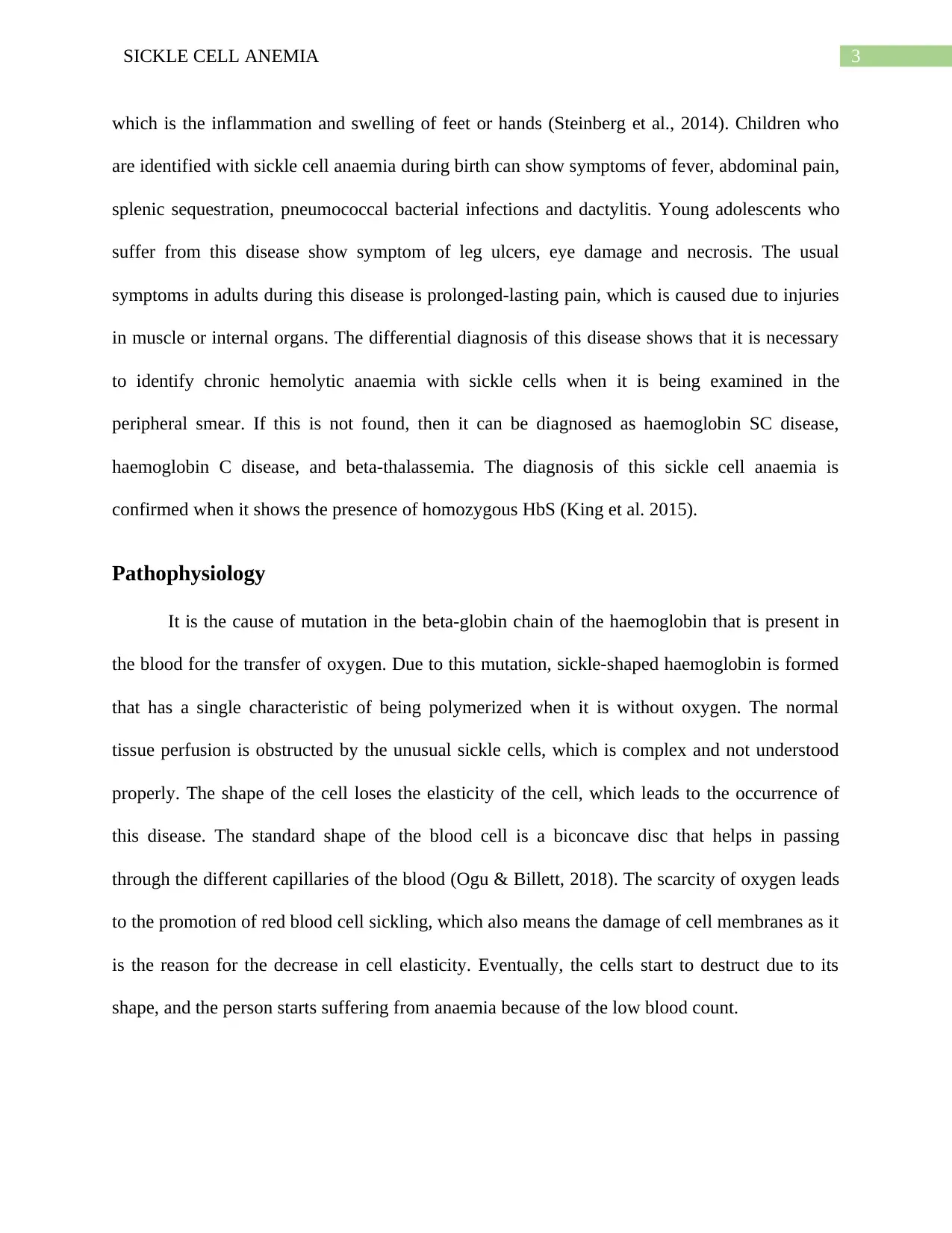
3SICKLE CELL ANEMIA
which is the inflammation and swelling of feet or hands (Steinberg et al., 2014). Children who
are identified with sickle cell anaemia during birth can show symptoms of fever, abdominal pain,
splenic sequestration, pneumococcal bacterial infections and dactylitis. Young adolescents who
suffer from this disease show symptom of leg ulcers, eye damage and necrosis. The usual
symptoms in adults during this disease is prolonged-lasting pain, which is caused due to injuries
in muscle or internal organs. The differential diagnosis of this disease shows that it is necessary
to identify chronic hemolytic anaemia with sickle cells when it is being examined in the
peripheral smear. If this is not found, then it can be diagnosed as haemoglobin SC disease,
haemoglobin C disease, and beta-thalassemia. The diagnosis of this sickle cell anaemia is
confirmed when it shows the presence of homozygous HbS (King et al. 2015).
Pathophysiology
It is the cause of mutation in the beta-globin chain of the haemoglobin that is present in
the blood for the transfer of oxygen. Due to this mutation, sickle-shaped haemoglobin is formed
that has a single characteristic of being polymerized when it is without oxygen. The normal
tissue perfusion is obstructed by the unusual sickle cells, which is complex and not understood
properly. The shape of the cell loses the elasticity of the cell, which leads to the occurrence of
this disease. The standard shape of the blood cell is a biconcave disc that helps in passing
through the different capillaries of the blood (Ogu & Billett, 2018). The scarcity of oxygen leads
to the promotion of red blood cell sickling, which also means the damage of cell membranes as it
is the reason for the decrease in cell elasticity. Eventually, the cells start to destruct due to its
shape, and the person starts suffering from anaemia because of the low blood count.
which is the inflammation and swelling of feet or hands (Steinberg et al., 2014). Children who
are identified with sickle cell anaemia during birth can show symptoms of fever, abdominal pain,
splenic sequestration, pneumococcal bacterial infections and dactylitis. Young adolescents who
suffer from this disease show symptom of leg ulcers, eye damage and necrosis. The usual
symptoms in adults during this disease is prolonged-lasting pain, which is caused due to injuries
in muscle or internal organs. The differential diagnosis of this disease shows that it is necessary
to identify chronic hemolytic anaemia with sickle cells when it is being examined in the
peripheral smear. If this is not found, then it can be diagnosed as haemoglobin SC disease,
haemoglobin C disease, and beta-thalassemia. The diagnosis of this sickle cell anaemia is
confirmed when it shows the presence of homozygous HbS (King et al. 2015).
Pathophysiology
It is the cause of mutation in the beta-globin chain of the haemoglobin that is present in
the blood for the transfer of oxygen. Due to this mutation, sickle-shaped haemoglobin is formed
that has a single characteristic of being polymerized when it is without oxygen. The normal
tissue perfusion is obstructed by the unusual sickle cells, which is complex and not understood
properly. The shape of the cell loses the elasticity of the cell, which leads to the occurrence of
this disease. The standard shape of the blood cell is a biconcave disc that helps in passing
through the different capillaries of the blood (Ogu & Billett, 2018). The scarcity of oxygen leads
to the promotion of red blood cell sickling, which also means the damage of cell membranes as it
is the reason for the decrease in cell elasticity. Eventually, the cells start to destruct due to its
shape, and the person starts suffering from anaemia because of the low blood count.
Paraphrase This Document
Need a fresh take? Get an instant paraphrase of this document with our AI Paraphraser
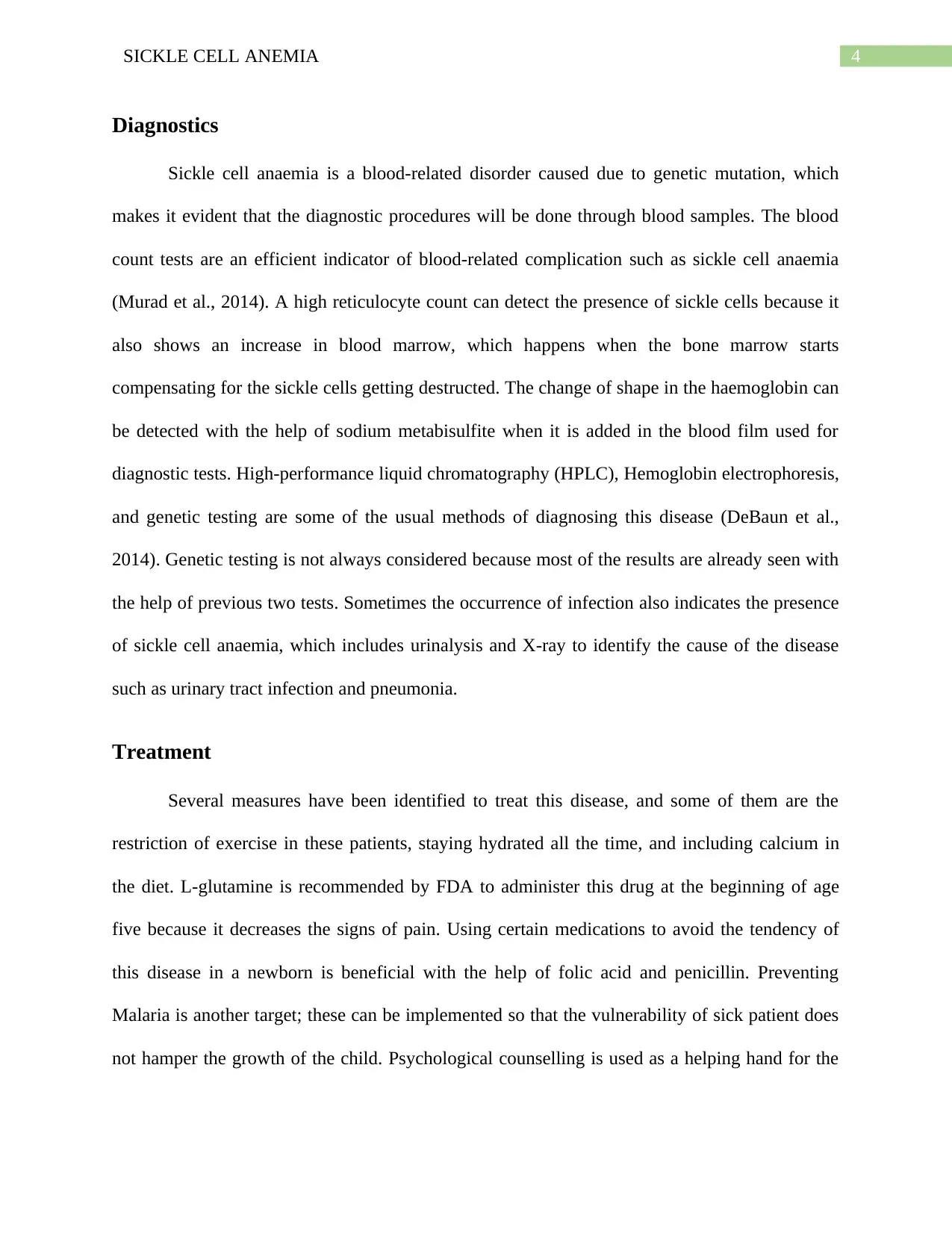
4SICKLE CELL ANEMIA
Diagnostics
Sickle cell anaemia is a blood-related disorder caused due to genetic mutation, which
makes it evident that the diagnostic procedures will be done through blood samples. The blood
count tests are an efficient indicator of blood-related complication such as sickle cell anaemia
(Murad et al., 2014). A high reticulocyte count can detect the presence of sickle cells because it
also shows an increase in blood marrow, which happens when the bone marrow starts
compensating for the sickle cells getting destructed. The change of shape in the haemoglobin can
be detected with the help of sodium metabisulfite when it is added in the blood film used for
diagnostic tests. High-performance liquid chromatography (HPLC), Hemoglobin electrophoresis,
and genetic testing are some of the usual methods of diagnosing this disease (DeBaun et al.,
2014). Genetic testing is not always considered because most of the results are already seen with
the help of previous two tests. Sometimes the occurrence of infection also indicates the presence
of sickle cell anaemia, which includes urinalysis and X-ray to identify the cause of the disease
such as urinary tract infection and pneumonia.
Treatment
Several measures have been identified to treat this disease, and some of them are the
restriction of exercise in these patients, staying hydrated all the time, and including calcium in
the diet. L-glutamine is recommended by FDA to administer this drug at the beginning of age
five because it decreases the signs of pain. Using certain medications to avoid the tendency of
this disease in a newborn is beneficial with the help of folic acid and penicillin. Preventing
Malaria is another target; these can be implemented so that the vulnerability of sick patient does
not hamper the growth of the child. Psychological counselling is used as a helping hand for the
Diagnostics
Sickle cell anaemia is a blood-related disorder caused due to genetic mutation, which
makes it evident that the diagnostic procedures will be done through blood samples. The blood
count tests are an efficient indicator of blood-related complication such as sickle cell anaemia
(Murad et al., 2014). A high reticulocyte count can detect the presence of sickle cells because it
also shows an increase in blood marrow, which happens when the bone marrow starts
compensating for the sickle cells getting destructed. The change of shape in the haemoglobin can
be detected with the help of sodium metabisulfite when it is added in the blood film used for
diagnostic tests. High-performance liquid chromatography (HPLC), Hemoglobin electrophoresis,
and genetic testing are some of the usual methods of diagnosing this disease (DeBaun et al.,
2014). Genetic testing is not always considered because most of the results are already seen with
the help of previous two tests. Sometimes the occurrence of infection also indicates the presence
of sickle cell anaemia, which includes urinalysis and X-ray to identify the cause of the disease
such as urinary tract infection and pneumonia.
Treatment
Several measures have been identified to treat this disease, and some of them are the
restriction of exercise in these patients, staying hydrated all the time, and including calcium in
the diet. L-glutamine is recommended by FDA to administer this drug at the beginning of age
five because it decreases the signs of pain. Using certain medications to avoid the tendency of
this disease in a newborn is beneficial with the help of folic acid and penicillin. Preventing
Malaria is another target; these can be implemented so that the vulnerability of sick patient does
not hamper the growth of the child. Psychological counselling is used as a helping hand for the
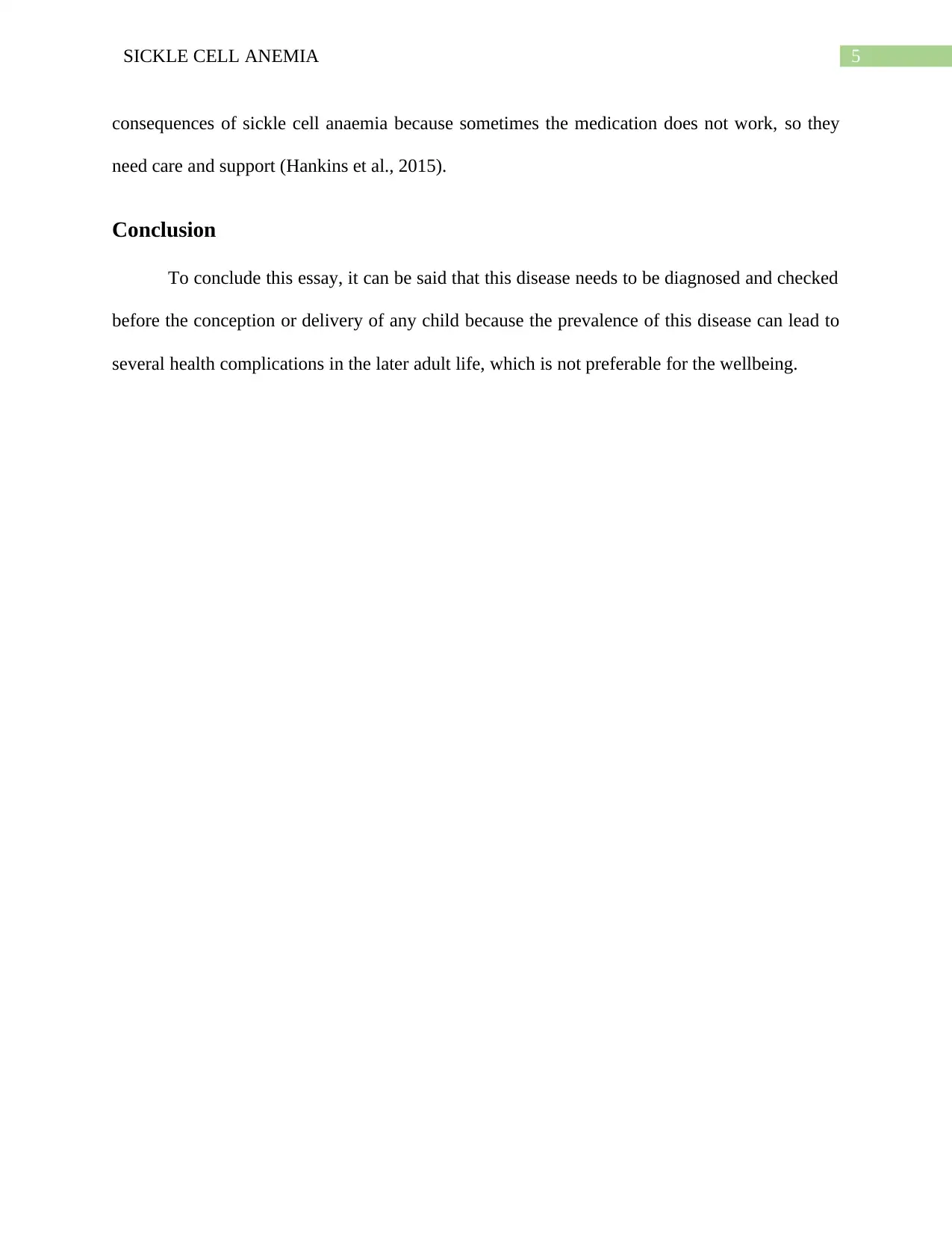
5SICKLE CELL ANEMIA
consequences of sickle cell anaemia because sometimes the medication does not work, so they
need care and support (Hankins et al., 2015).
Conclusion
To conclude this essay, it can be said that this disease needs to be diagnosed and checked
before the conception or delivery of any child because the prevalence of this disease can lead to
several health complications in the later adult life, which is not preferable for the wellbeing.
consequences of sickle cell anaemia because sometimes the medication does not work, so they
need care and support (Hankins et al., 2015).
Conclusion
To conclude this essay, it can be said that this disease needs to be diagnosed and checked
before the conception or delivery of any child because the prevalence of this disease can lead to
several health complications in the later adult life, which is not preferable for the wellbeing.
⊘ This is a preview!⊘
Do you want full access?
Subscribe today to unlock all pages.

Trusted by 1+ million students worldwide
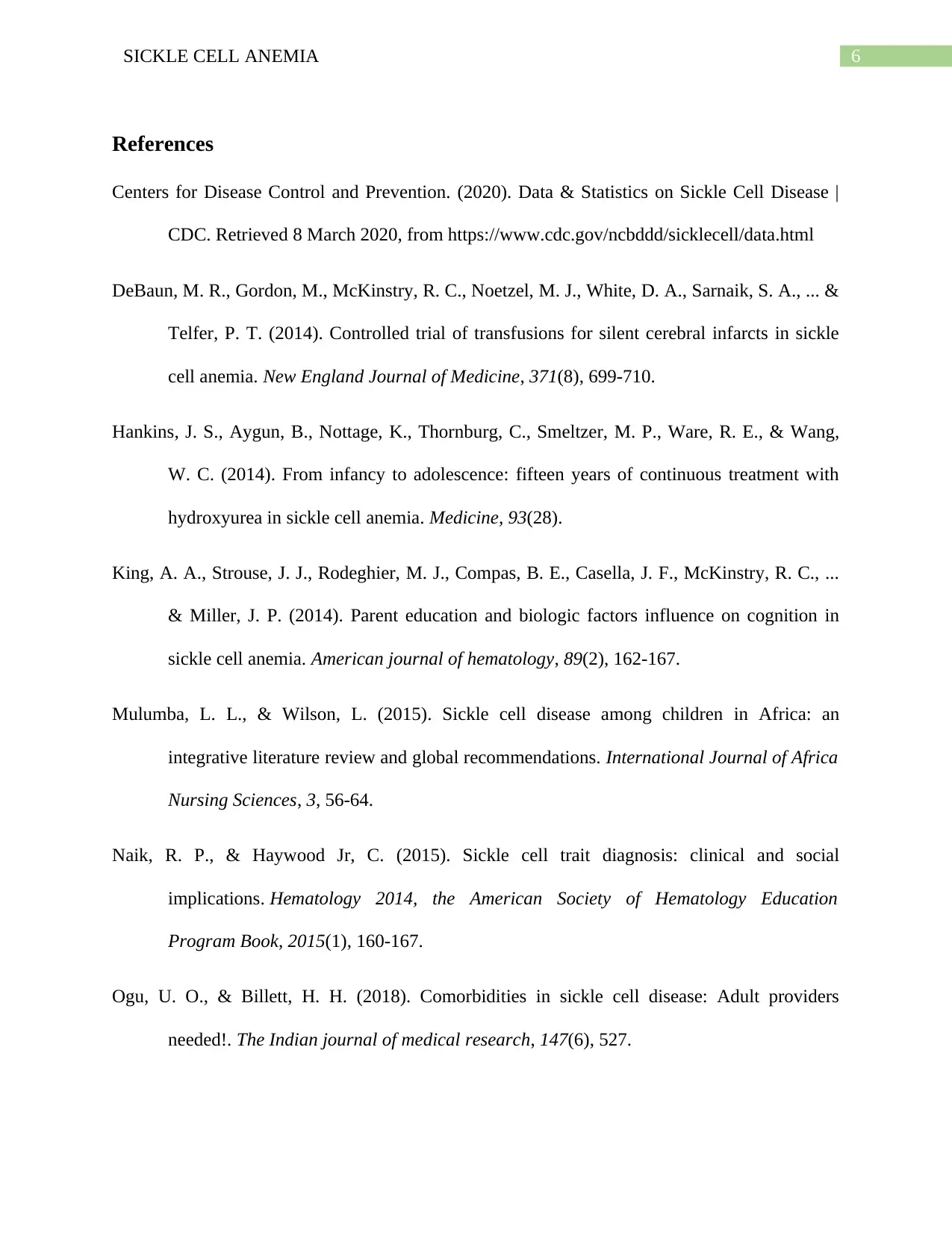
6SICKLE CELL ANEMIA
References
Centers for Disease Control and Prevention. (2020). Data & Statistics on Sickle Cell Disease |
CDC. Retrieved 8 March 2020, from https://www.cdc.gov/ncbddd/sicklecell/data.html
DeBaun, M. R., Gordon, M., McKinstry, R. C., Noetzel, M. J., White, D. A., Sarnaik, S. A., ... &
Telfer, P. T. (2014). Controlled trial of transfusions for silent cerebral infarcts in sickle
cell anemia. New England Journal of Medicine, 371(8), 699-710.
Hankins, J. S., Aygun, B., Nottage, K., Thornburg, C., Smeltzer, M. P., Ware, R. E., & Wang,
W. C. (2014). From infancy to adolescence: fifteen years of continuous treatment with
hydroxyurea in sickle cell anemia. Medicine, 93(28).
King, A. A., Strouse, J. J., Rodeghier, M. J., Compas, B. E., Casella, J. F., McKinstry, R. C., ...
& Miller, J. P. (2014). Parent education and biologic factors influence on cognition in
sickle cell anemia. American journal of hematology, 89(2), 162-167.
Mulumba, L. L., & Wilson, L. (2015). Sickle cell disease among children in Africa: an
integrative literature review and global recommendations. International Journal of Africa
Nursing Sciences, 3, 56-64.
Naik, R. P., & Haywood Jr, C. (2015). Sickle cell trait diagnosis: clinical and social
implications. Hematology 2014, the American Society of Hematology Education
Program Book, 2015(1), 160-167.
Ogu, U. O., & Billett, H. H. (2018). Comorbidities in sickle cell disease: Adult providers
needed!. The Indian journal of medical research, 147(6), 527.
References
Centers for Disease Control and Prevention. (2020). Data & Statistics on Sickle Cell Disease |
CDC. Retrieved 8 March 2020, from https://www.cdc.gov/ncbddd/sicklecell/data.html
DeBaun, M. R., Gordon, M., McKinstry, R. C., Noetzel, M. J., White, D. A., Sarnaik, S. A., ... &
Telfer, P. T. (2014). Controlled trial of transfusions for silent cerebral infarcts in sickle
cell anemia. New England Journal of Medicine, 371(8), 699-710.
Hankins, J. S., Aygun, B., Nottage, K., Thornburg, C., Smeltzer, M. P., Ware, R. E., & Wang,
W. C. (2014). From infancy to adolescence: fifteen years of continuous treatment with
hydroxyurea in sickle cell anemia. Medicine, 93(28).
King, A. A., Strouse, J. J., Rodeghier, M. J., Compas, B. E., Casella, J. F., McKinstry, R. C., ...
& Miller, J. P. (2014). Parent education and biologic factors influence on cognition in
sickle cell anemia. American journal of hematology, 89(2), 162-167.
Mulumba, L. L., & Wilson, L. (2015). Sickle cell disease among children in Africa: an
integrative literature review and global recommendations. International Journal of Africa
Nursing Sciences, 3, 56-64.
Naik, R. P., & Haywood Jr, C. (2015). Sickle cell trait diagnosis: clinical and social
implications. Hematology 2014, the American Society of Hematology Education
Program Book, 2015(1), 160-167.
Ogu, U. O., & Billett, H. H. (2018). Comorbidities in sickle cell disease: Adult providers
needed!. The Indian journal of medical research, 147(6), 527.
Paraphrase This Document
Need a fresh take? Get an instant paraphrase of this document with our AI Paraphraser

7SICKLE CELL ANEMIA
Sandhu, M. K., & Cohen, A. (2015). Aging in sickle cell disease: comorbidities and new issues
in management. Hemoglobin, 39(4), 221-224.
Steinberg, M. H., Chui, D. H., Dover, G. J., Sebastiani, P., & Alsultan, A. (2014). Fetal
hemoglobin in sickle cell anemia: a glass half full?. Blood, The Journal of the American
Society of Hematology, 123(4), 481-485.
Murad, H., Moassas, F., Jarjour, R., Mukhalalaty, Y., & Al-Achkar, W. (2014). Prenatal
molecular diagnosis of β-thalassemia and sickle cell anemia in the Syrian
population. Hemoglobin, 38(6), 390-393.
Sandhu, M. K., & Cohen, A. (2015). Aging in sickle cell disease: comorbidities and new issues
in management. Hemoglobin, 39(4), 221-224.
Steinberg, M. H., Chui, D. H., Dover, G. J., Sebastiani, P., & Alsultan, A. (2014). Fetal
hemoglobin in sickle cell anemia: a glass half full?. Blood, The Journal of the American
Society of Hematology, 123(4), 481-485.
Murad, H., Moassas, F., Jarjour, R., Mukhalalaty, Y., & Al-Achkar, W. (2014). Prenatal
molecular diagnosis of β-thalassemia and sickle cell anemia in the Syrian
population. Hemoglobin, 38(6), 390-393.
1 out of 8
Related Documents
Your All-in-One AI-Powered Toolkit for Academic Success.
+13062052269
info@desklib.com
Available 24*7 on WhatsApp / Email
![[object Object]](/_next/static/media/star-bottom.7253800d.svg)
Unlock your academic potential
Copyright © 2020–2025 A2Z Services. All Rights Reserved. Developed and managed by ZUCOL.




